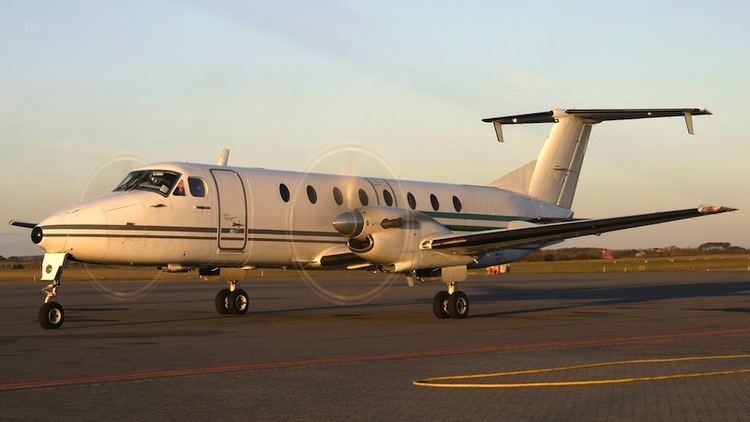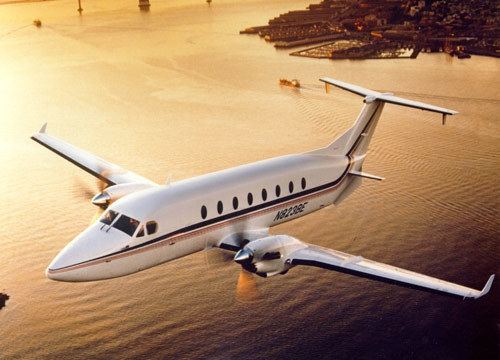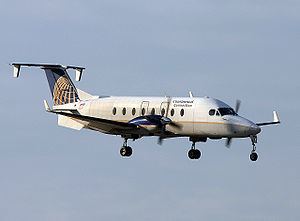Length 18 m Number of seats 19 | Introduced February 1983 | |
 | ||
Unit cost 4,995,000–4,995,000 USD (2001) Engine type Pratt & Whitney Canada PT6 Manufacturers Hawker Beechcraft, Raytheon, Beechcraft Similar Beechcraft Model 99, Beechcraft Model 18, De Havilland Canada DHC 6 Twin Otter | ||
Beechcraft 1900 startup and takeoff
The Beechcraft 1900 is a 19-passenger, pressurized twin-engine turboprop fixed-wing aircraft that was manufactured by Beechcraft. It was designed, and is primarily used, as a regional airliner. It is also used as a freight aircraft and corporate transport, and by several governmental and military organisations. With customers favoring larger regional jets, Raytheon ended production in October 2002.
Contents
- Beechcraft 1900 startup and takeoff
- Hawker beech beechcraft 1900c
- Development
- Design
- Propulsion
- Performance
- 1900
- 1900C
- 1900D
- Military C 12J
- King Air ExecLiner
- Civilian operators
- Military operators
- Accidents and incidents
- Specifications Beechcraft 1900D
- References

The aircraft was designed to carry passengers in all weather conditions from airports with relatively short runways. It is capable of flying in excess of 600 miles (970 km), although few operators use its full-fuel range. In terms of the number of aircraft built and its continued use by many passenger airlines and other users, it is one of the most popular 19-passenger airliners in history.

Hawker beech beechcraft 1900c
Development

The 1900 is Beechcraft's third Regional airliner. The Beechcraft Model 18 was a 6- to 11-passenger utility aircraft produced from 1937 to 1970, used by the military, airlines, charter operations, corporations for executive transport, and freight carriers. The 15-passenger Beechcraft Model 99 Airliner was designed to replace the Beech 18, and was produced between 1966 and 1975, and from 1982 to 1986. It was also commercially successful and remains in common use with freight airlines such as Ameriflight.

The Beechcraft 1900's design lineage began in 1949 with the Beechcraft Model 50 "Twin Bonanza", a 5-passenger, reciprocating engine utility aircraft designed for the U.S. Army. A larger passenger cabin was added to the Twin Bonanza's airframe, and called the Model 65 "Queen Air." This aircraft was, in turn, further modified by adding turboprop engines and cabin pressurization, and named the Model 90 "King Air." A stretched version of the King Air was later developed and designated the Model 200 "Super King Air". Beechcraft developed the Beechcraft 1900 directly from the Beechcraft Super King Air, in order to provide a pressurized commuterliner to compete with the Swearingen Metro and the British Aerospace Jetstream.
The 1900 first flew on September 3, 1982, with Federal Aviation Administration (FAA) certification awarded on November 22, 1983 under Special Federal Aviation Regulation (SFAR) 41C airworthiness standards. Like the 1900, the 1900C was certified under SFAR 41C, but the later 1900D version was certified to FAR Part 23 "Commuter Category" standards.
The 1900 entered service in February 1984, with the first ExecLiner corporate version delivered in 1985. A total of 695 Beechcraft 1900 aircraft were built, making the airliner the best-selling 19-passenger airliner in history. With market trends favoring larger 50- to 90-seat regional jets, Raytheon ended production of the Beechcraft 1900 in October 2002. Many airlines continue to fly the 1900.
Design
Since the 1900 is derived from the King Air, all 1900s share certain characteristics with that aircraft. Cockpit controls and operations are similar to those of the King Air. While Federal Aviation Regulations require two pilots for passenger airline operations, the 1900 is designed and certificated for single-pilot operation in corporate or cargo settings, as is the King Air.
Propulsion
The 1900 is powered by two Pratt & Whitney Canada PT6A turboprop engines. The 1900 and 1900C use two PT6A-65B engines, each flat rated at 1,100 shaft horsepower (820 kW). The 1900D uses two PT6A-67D engines, each rated at 1,279 shaft horsepower (954 kW).
The propellers are manufactured by Hartzell, with four blades on each propeller. The blades are made from composite materials.
Jet A is the recommended fuel. However, the engines are also approved for limited operations on other types of jet fuel or aviation-grade gasoline.
Performance
The 1900D cruises at about 285 knots (328 mph or 528 km/h) true airspeed. Ordinary trip lengths range from 100 to 600 miles (20 minutes to two hours), but with full fuel tanks, the aircraft is capable of flying well in excess of 1,000 nautical miles (1,900 km). Airlines often prefer the 1900 over jet aircraft for shorter routes due to its fuel efficiency, and because trip times are not significantly longer on distances up to 300 miles (480 km).
The Beechcraft 1900 can operate safely on relatively short airstrips and it can take off and land on grass and rough runways.
The airplane is certified to fly up to an altitude of 25,000 feet (7,600 m) above mean sea level with its pressurized cabin. It is designed to operate in most weather conditions, including icing conditions, and it is usually equipped with weather radar to help pilots avoid severe weather. The aircraft can be fitted with an optional lavatory, using space otherwise available for passenger seating and cargo storage.
1900
The original design is known simply as the Beechcraft 1900. It features two "airstair" passenger boarding doors: one near the tail of the aircraft much like the smaller King Airs, and a second at the front just behind the cockpit. It has a small cargo door near the tail for access to the baggage compartment, which is behind the passenger compartment. Only three airframes were built, with "UA" serial numbers of UA-1, UA-2, and UA-3. UA-1 and UA-2 are stored at a Beechcraft facility in Wichita, Kansas. UA-3, registered FAB-043, served in Bolivia until it crashed in November 2011.
1900C
It quickly became clear that having two airstair doors on an aircraft holding only 19 passengers was excessive. In creating the 1900C, Beechcraft kept the front airstair, but eliminated the aft airstair door, installing an enlarged cargo door in its place. Other than the redesigned door layout, the early 1900Cs were substantially similar to the original 1900s. These were assigned serial numbers starting with the letters UB. A total of 74 UB version were built, many of which remain in service. Aircraft in the UA and UB series employ a bladder-type fuel tank system in the wings. Later 1900Cs use a "wet wing" fuel system: entire sections of the wing are sealed off for use as fuel tanks. This design change allowed more fuel to be stored, substantially increasing the 1900C's range. The wet wing 1900Cs were assigned serial numbers beginning with "UC." These aircraft are also referred to as 1900C-1s. The wet wings proved popular, and the UC is the most common version of the low-ceiling 1900, with 174 UC airframes built.
Raytheon manufactured six 1900C aircraft for use by the U.S. military. These were assigned "UD" serial numbers, UD-1 through UD-6.
1900D
While the 1900C had become a popular regional airliner, Beechcraft undertook a substantial redesign of the aircraft, and in 1991 introduced a new version called the 1900D.
The 1900 and 1900C, like most 19-passenger airliners and business jets, have fairly small passenger cabins, with ceilings so low that passengers cannot walk through the interior without bending forward. The 1900D was designed to remedy this by providing a "stand-up cabin", which would allow most passengers to walk upright. It is one of only two 19-seat airliners with this feature, the other being the British Aerospace Jetstream 31/32.
Because the taller passenger cabin adds both weight and drag to the airplane, other elements of the 1900D were also changed. More powerful engines and modified propellers were installed, winglets were added to reduce drag and increase the wings' efficiency, and the tail was made larger in response to the more powerful engines. The cockpit was updated with an Electronic Flight Instrument System (EFIS). The 1900D was certified under the then-new FAR Part 23 "Commuter Category" standards, which had replaced the earlier SFAR 41C. Since the UD serial numbers were already in use by the military 1900s, the 1900D airplanes have serial numbers beginning with UE. The 1900D is the most popular version of the airliner, with 439 of the 1900D built.
Military C-12J
The U.S. military designation for the Beechcraft 1900C is C-12J. This is a variant of the C-12 Huron, which is the most common designation for military King Airs. The C-12J includes the 6 UD series Beechcraft 1900s built for the U.S. military, as well as other 1900Cs in U.S. military service.
Examples of C-12J aircraft in military service include one used for GPS jamming tests at the 586th Flight Test Squadron, Holloman Air Force Base, New Mexico, and three based at the 459th Airlift Squadron, Yokota Air Base, Japan. The U.S. Army operates both C-12J and 1900D aircraft along with other C-12 (King Air) aircraft.
King Air ExecLiner
The King Air ExecLiner was a marketing name for a corporate version of the Beechcraft 1900C.
Civilian operators
1900C. As of July 2015, there were 120 in service with over 30 operators; including Alpine Air (16), Ameriflight (25), and SkyLink Express (9).
1900D. As of July 2015, there were 221 in service with over 50 operators; including Great Lakes Airlines (28), SEARCA Colombia (16) and Central Mountain Air (12).
Military operators
Military and government operators include:
Accidents and incidents
Specifications (Beechcraft 1900D)
Data from Raytheon: Beechcraft 1900D Passenger Specifications and Performance
General characteristics
Performance
Avionics
